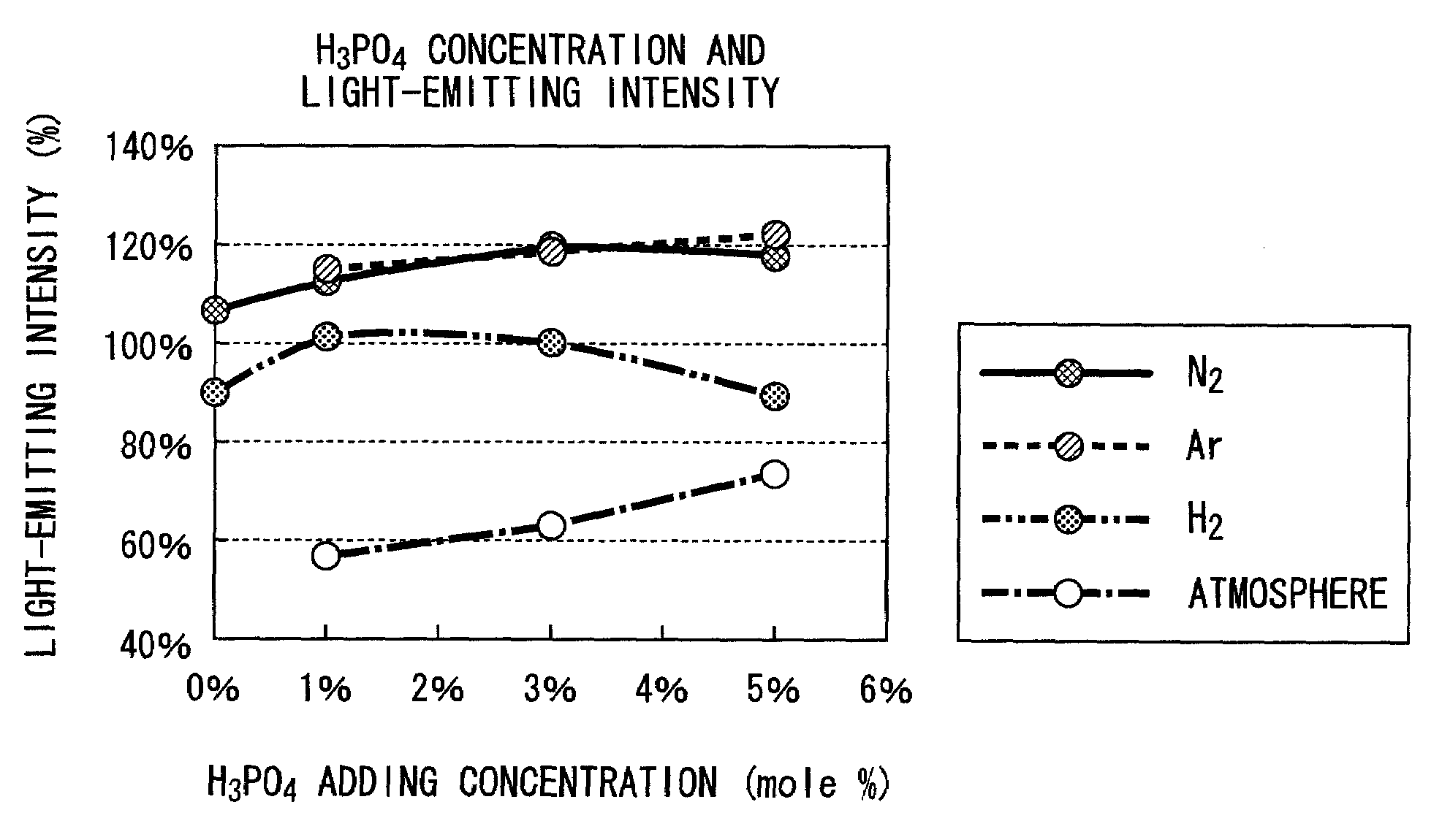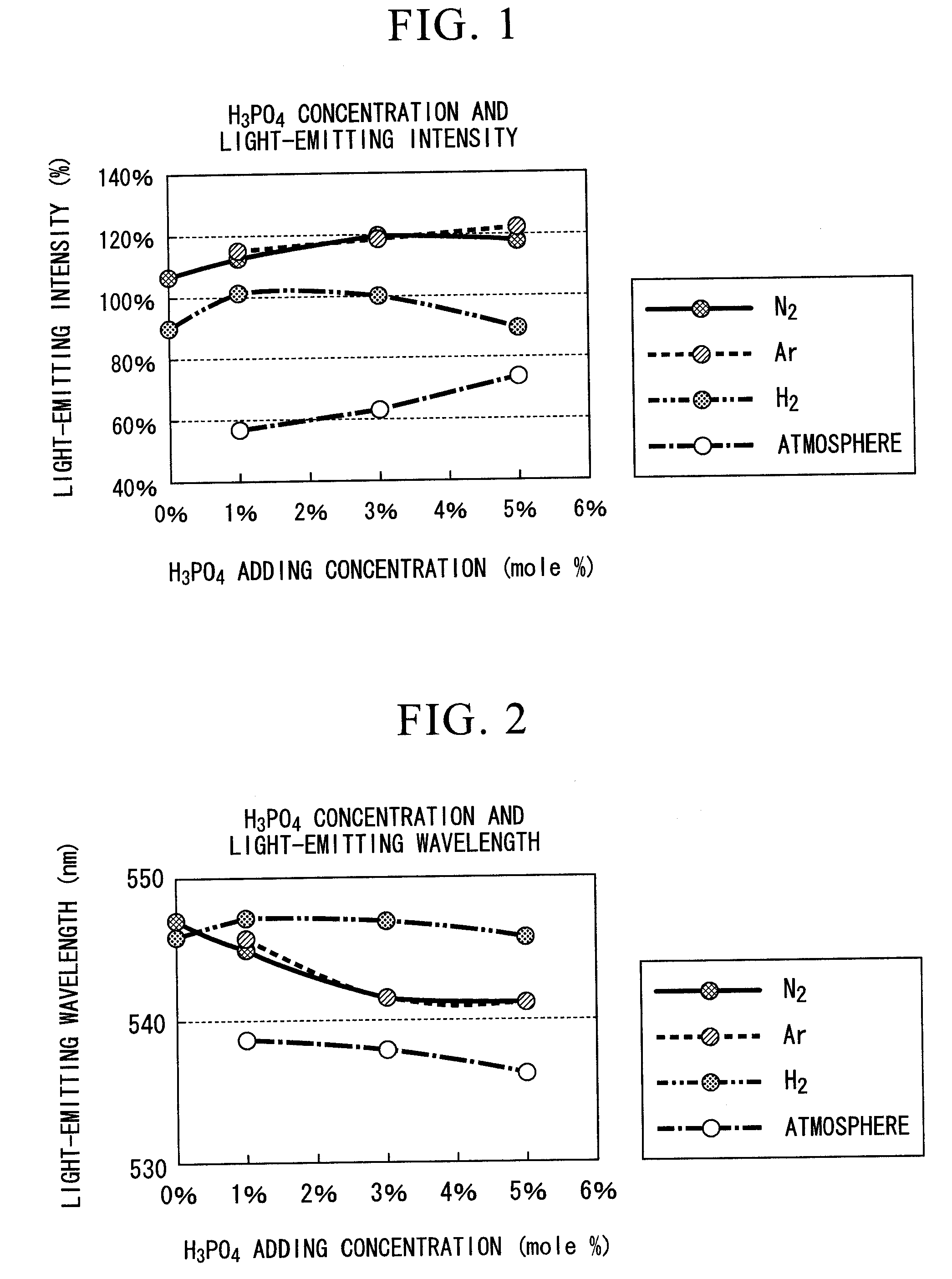Fluorescent substance and process for producing the same
a technology of fluorescent substances and processes, applied in non-linear optics, lighting and heating apparatuses, instruments, etc., to achieve excellent light-emitting properties, increase light-emitting intensity, and high intensity
- Summary
- Abstract
- Description
- Claims
- Application Information
AI Technical Summary
Benefits of technology
Problems solved by technology
Method used
Image
Examples
example 1
[0079]FIGS. 1 and 2 are graphs which show the relative intensity (light-emitting intensity) of the maximum light-emitting peak height, and the wavelength (light-emitting wavelength) of the maximum light-emitting peak height of the fluorescent substance which was synthesized by compounding each of Y2O3, Al2O3 and CeO2 so as to be Y2.91Ce0.09Al5O12, and adding H3PO4 as an element of group V to this, while varying the additive amount and calcining atmosphere.
[0080]As an atmosphere for calcining of the data shown in FIGS. 1 and 2, approximately 100% gas was used respectively in each of “Ar” and “N2”, a mixed gas consisting of 4% of hydrogen and 96% of nitrogen was used in “H2”, and an atmospheric air was used in “Atmosphere” for calcining.
[0081]As a fluorescent substance for comparison, TYPE: KX692B made by KASEI OPTO Co., Ltd. was used. This fluorescent substance is one which has the largest light-emitting intensity in all of commercially available fluorescent substances, having a ligh...
example 2
[0089]FIGS. 3 and 4 are graphs which show the relative intensity (light-emitting intensity) of the maximum light-emitting peak height, and the wavelength (light-emitting wavelength) of the maximum light-emitting peak height of the fluorescent substance which was synthesized by compounding each of Y2O3, Al2O3 and CeO2 so as to be Y(3-X)CeXAl5O12, and adding a predetermined amount of 3 mole % of H3PO4 as an element of group V to this, while varying the CeO2 concentration x (mole %) and calcining atmosphere.
[0090]As an atmosphere for calcining of the data shown in FIGS. 3 and 4, approximately 100% gas was used in “N2”, and a mixed gas consisting of 4% of hydrogen and 96% of nitrogen was used in “H2”.
[0091]As a fluorescent substance for comparison, TYPE: KX692B made by KASEI OPTO Co., Ltd. was used, the same as in Example 1.
[0092]The correlation between the CeO2 (Ce) concentration in the state in which H3PO4 was added to the fluorescent substance, and the light-emitting intensity is sho...
example 3
[0100]FIG. 5 is a graph which shows the correlation between the concentration of P which was added during synthesizing the fluorescent substance raw material and the concentration of P contained in the fluorescent substance after the fluorescent substance was synthesized, in the case of synthesizing a fluorescent substance by compounding each of Y2O3, Al2O3 and CeO2 so as to be Y2.91Ce0.09Al5O12, and adding various P (phosphorus) compounds as an element of group V thereinto, while varying the calcining atmosphere.
[0101]In FIG. 5, each of A, B, C, and D is an example which was performed by changing the kind of P compound and the calcining atmosphere.
[0102]From the result shown in FIG. 5, it can be seen that each concentration of P which was added during synthesizing the fluorescent substance raw material and the concentration of P contained in the fluorescent substance after the fluorescent substance was synthesized varies depending on conditions such as the kind of compound of P sou...
PUM
 Login to View More
Login to View More Abstract
Description
Claims
Application Information
 Login to View More
Login to View More - R&D
- Intellectual Property
- Life Sciences
- Materials
- Tech Scout
- Unparalleled Data Quality
- Higher Quality Content
- 60% Fewer Hallucinations
Browse by: Latest US Patents, China's latest patents, Technical Efficacy Thesaurus, Application Domain, Technology Topic, Popular Technical Reports.
© 2025 PatSnap. All rights reserved.Legal|Privacy policy|Modern Slavery Act Transparency Statement|Sitemap|About US| Contact US: help@patsnap.com



